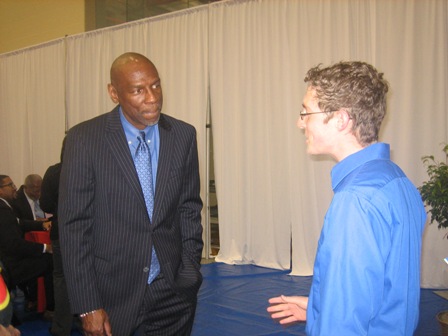Geoffrey Canada, president and CEO of the Harlem Children’s Zone (HCZ), spoke at the University of Dayton last week as part of the university’s diversity lecture series. (You can read Dayton Daily News’ nice coverage of it here.) Fordham’s hometown of Dayton is the perfect place to hear Canada’s message. It’s one of Ohio’s poorest cities, and despite all of our efforts on the ground there, the city is a constant reminder of how tragically difficult it is to improve outcomes for poor kids. In Dayton Public Schools, over three fourths of kids attend a school rated D or F. No children go to a school rated Excellent.
Canada’s assessment for Dayton – and the nation – is right. Our communities simply can’t afford to have so many young people unemployed (or in jail), especially African American boys. It’s an issue of global competitiveness and our economic health, but more than that – a moral and spiritual imperative.
Beyond that, one piece of his message really stood out: here in Ohio, we’ve been busy for the past several years thinking about state-level policy issues that inhibit districts and schools from serving kids better, and pushing to lift roadblocks when it comes to reforming K-12 education. Now perhaps more than ever, the Buckeye State stands a chance at successfully rolling back senseless laws and requirements, and untying districts’ hands so that they can pursue meaningful reforms. However, there still remains a gap between what state or local-level policy can achieve, and what it takes to actually exterminate achievement gaps. In that space resides a level of leadership, activism, and drive (that Canada embodies perfectly) that is both difficult to measure and hard to foster. It’s not like you can just plant a Geoffrey Canada down in Dayton and other urban communities and wait for grassroots reform to grow.
As Canada described how HCZ’s work unfolded, it was a good reminder of the role that local leadership and home-grown reform plays in K-12 transformation: “No one from the federal or state or whatever level of government was going to come in and fix it for us. We didn’t ask permission; we just did it.” The 21 Promise Neighborhoods across the US (winning federal grants to try to create similar “zones”) will illustrate the extent to which the concept can be replicated.
Until then, Canada’s words both inspire and cause slight anxiety: “Hope is as infectious as despair.” That’s true, but only comforting to a small degree because it’s far easier to work in the realm of policies, legislative language, regulations, and rules than it is to deal with the more enigmatic aspects of the human spirit and translate these qualities into tangible improvements for kids. At the risk of sounding like a broken record, human capital matters enormously in strengthening communities – both drawing in talented individuals and keeping them. Even if Ohio can make great progress in changing policies/legislation, issues of human capital loom large and are integral to the state’s long-term ability to help kids most in need. Kudos to Canada for the reminder.
